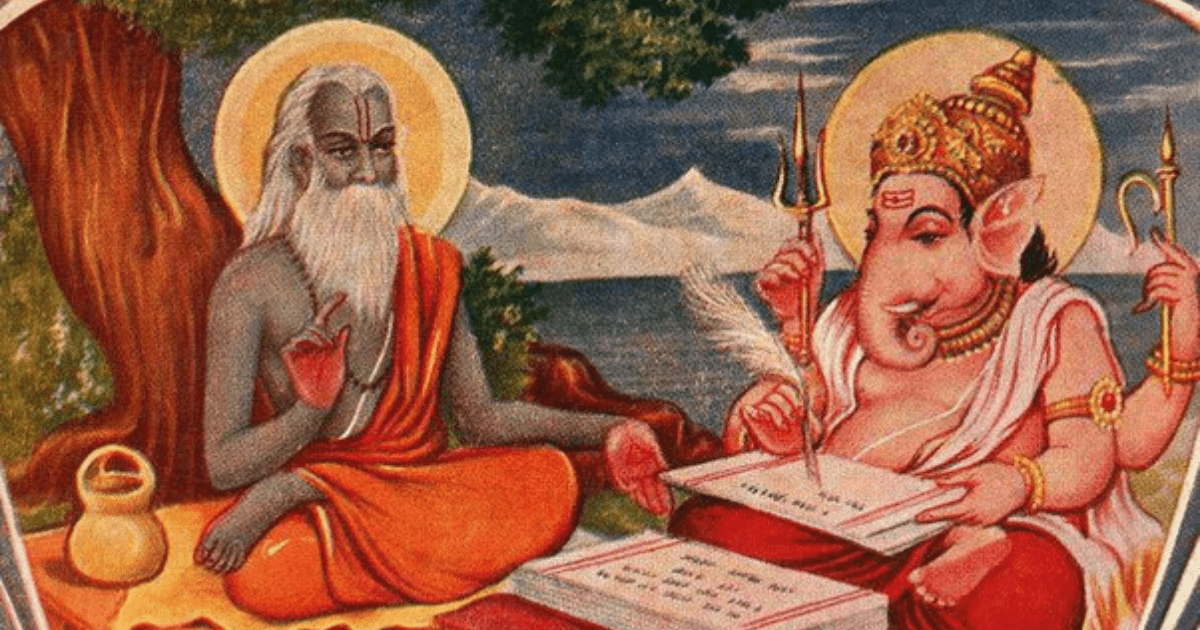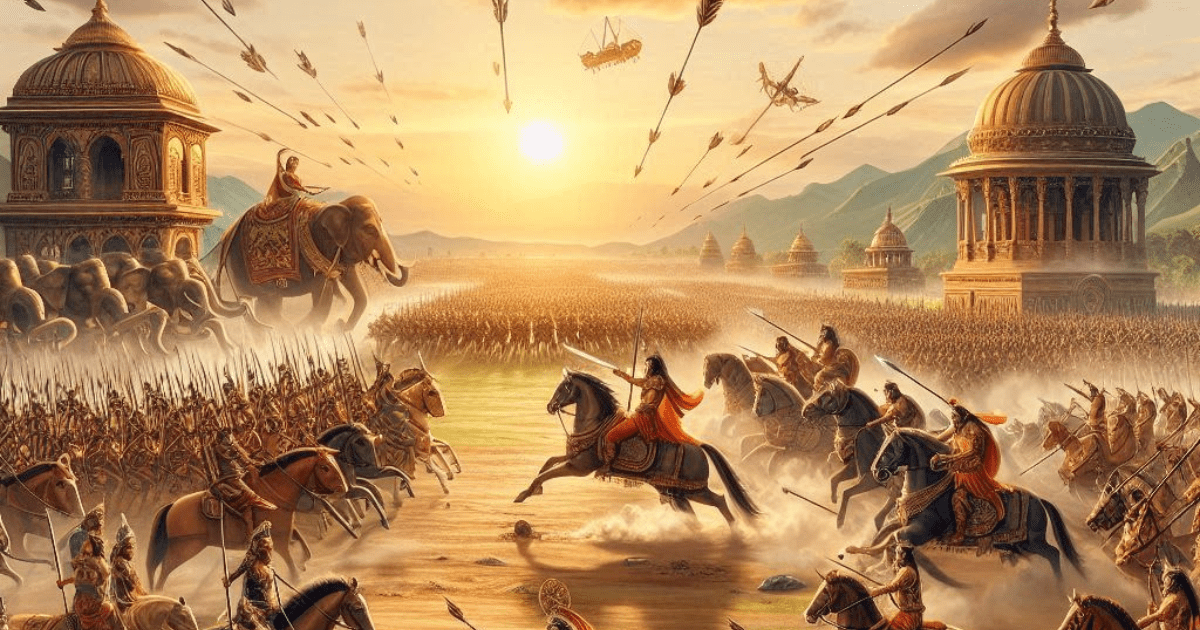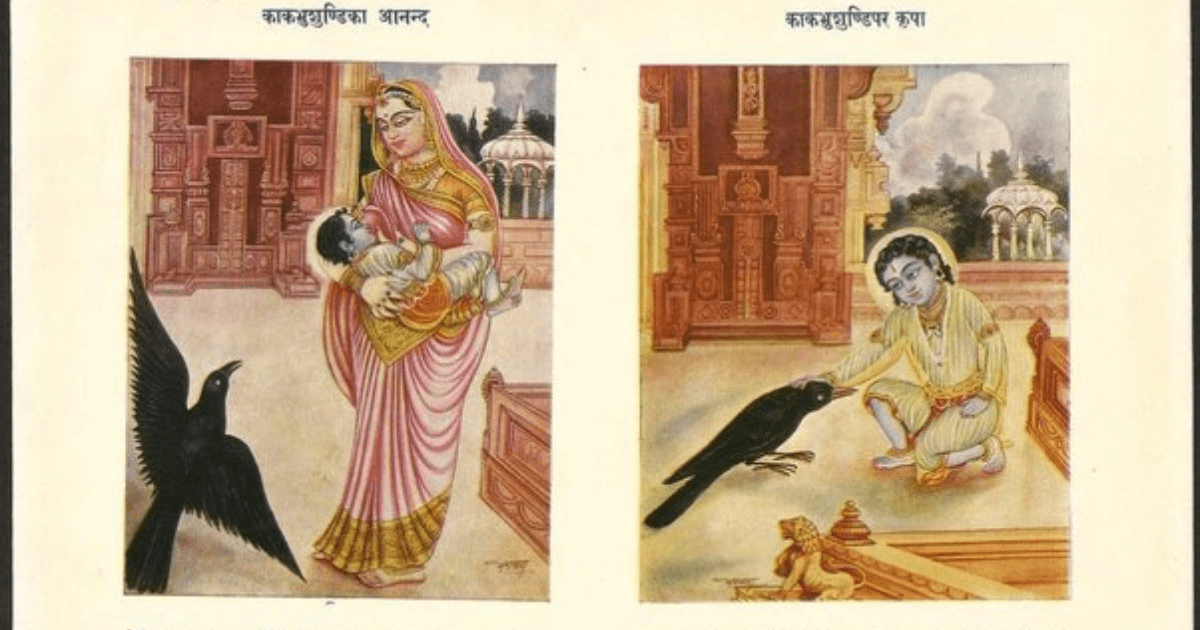The Mahabharata is a pioneering Sanskrit Tale in Indian mythology, it tells about the rise and fall of the Kuru Dynasty. The origins of Mahabharat lie in the interaction between Sage Vyasa and Lord Ganesha. Lord Vyasa envisioned Mahabharat in his dream, understanding the vast scope and complexity of Mahabharat, Vyasa sought a scribe capable of matching his speed and depth of thought. This post is all about it. You will find out who wrote Mahabharata, and how it was written.
Table of Contents
Who Wrote Mahabharata?
Vyasa envisioned Mahabharata in his dreams. But the Mahabharata was so vast and complex, it needed a special someone to write it all down. Vyasa knew he couldn’t do it alone, he sought a scribe capable of matching his speed and depth of thought, someone who could understand the deep meaning behind every word. Vyasa asked for Lord Ganesha’s help to write down Mahabharata.
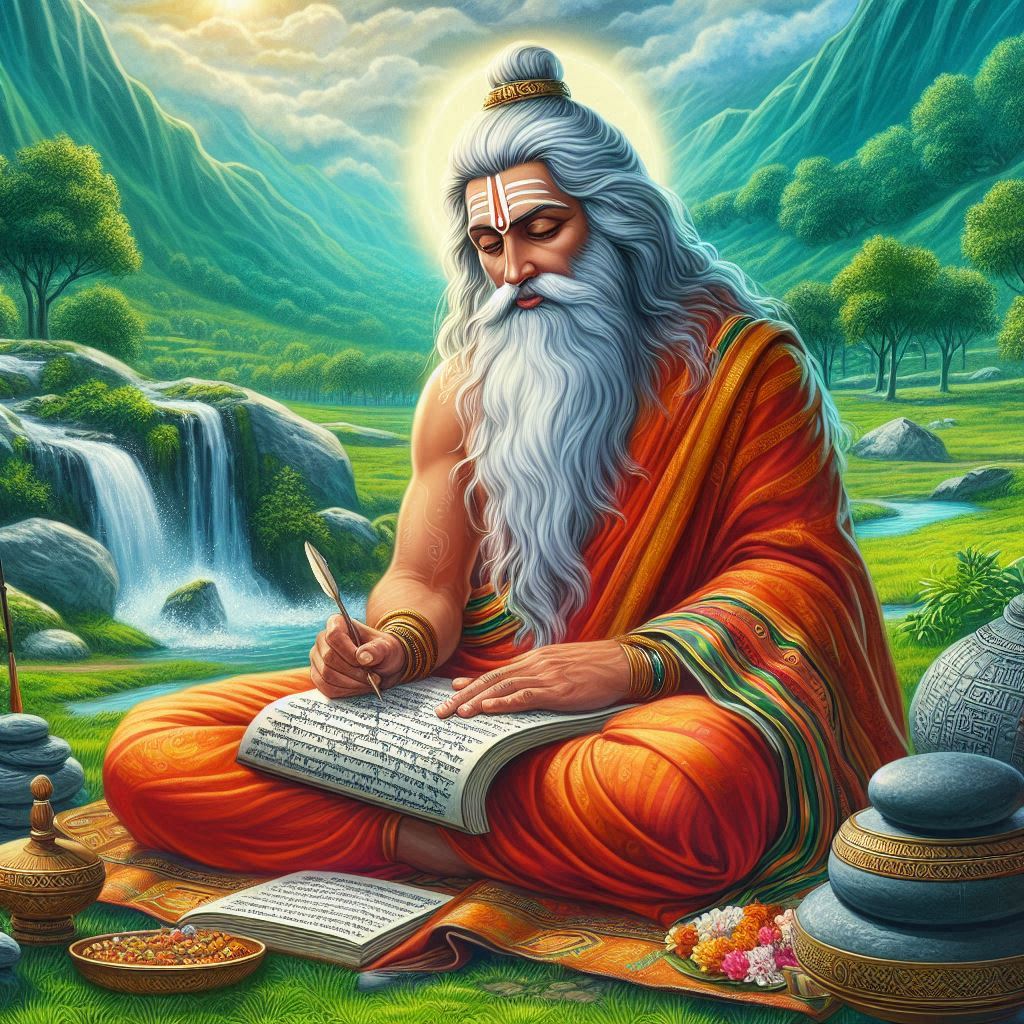
Ganesha was known for his immense wisdom and his incredible memory. He could remember everything he heard, making him the perfect scribe for this epic tale. But there was a small problem. Ganesha, although super smart, wasn’t exactly known for his speed.
Vyasa worried that Ganesha wouldn’t be able to keep up with his fast-flowing story. Sensing Vyasa’s hesitation, Ganesha, with a mischievous twinkle in his eye, made a proposition. He said, “Great sage, I will write down your story, but on one condition. You must tell it without stopping, not even for a moment. If you pause, even to take a breath, I will not be able to continue.”
Vyasa’s devotion made him agree to this proposition. He took a deep breath and began the process of writing Mahabharata. He spoke of gods and mortals, of battles and friendships, of love and betrayal. Vyasa poured his heart and soul into the narration, highlighting every detail, every emotion, with clarity. But Ganesha wasn’t just writing; he was listening intently, absorbing the deeper meaning behind each word.
Ganesha As Vyasa’s Scribe
Ganesha is a symbol of Riddhi and Siddhi in Hindu Mythology. He agreed to be the scribe, but only on one condition: Vyasa had to narrate the entire Mahabharata in one go. Not even a moment to catch his breath! If the flow of words stopped, so would Ganesha.
When sage Vyasa approached Ganesha to be the scribe for the Mahabharata – it was a significant choice. Ganesha possesses vast intellect and memory, which makes him the perfect scribe. Ganesha, ever the clever one, presented a unique challenge to Vyasa. Vyasa understood the significance of the Mahabharata.
It wasn’t just a story; it was a repository of knowledge meant to guide future generations. Vyasa countered with his own condition. He agreed to narrate without stopping, but only if Ganesha truly understood each verse before writing it down, resulting in the legendary Sanskrit Tale Mahabharata.
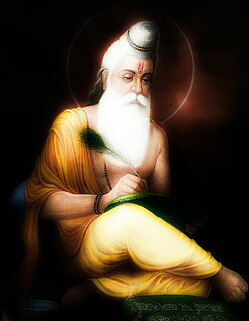
Also Read: Who Watched Mahabharata 16 Times?
The Composition Of Mahabharata
The Mahabharata narrates the epic struggle for sovereignty between two princely cousins: the Kauravas (descendants of Dhritarashtra) and the Pāṇḍavas (sons of Pandu). Their conflict culminates in the Kurukshetra War, a battle of cosmic proportions. Traditionally attributed to the sage Vyāsa, the Mahabharata is a monumental work. Vyāsa, himself a character in the epic, dictated its verses to Ganesha, who faithfully transcribed them.
The Mahabharata is the longest epic poem ever written, stretching over 100,000 verses (or more than 200,000 individual lines). To put it in perspective, it’s about ten times the length of both the Iliad and the Odyssey combined!
The Mahabharata features deep discussions, like in the Bhagavad Gita. It explores the four goals of life known as Puruṣārtha: Dharma (Duty), Artha (Prosperity), Kāma (Desire), and Mokṣa (Liberation).
The epic’s composition spans centuries, the bulk was likely compiled between the 3rd century BCE and the 3rd century CE. By the early Gupta period (around the 4th century CE), the Mahabharata reached its final form. Its title translates as “Great Bharat (India)” or simply “The Great Indian Tale.”
Who Translated Mahabharata In English?
It wasn’t until the 19th century when Kisari Mohan Ganguli also known as K.M. Ganguli, first translated Mahabharata in English. His translation, titled “The Mahabharata of Krishna-Dwaipayana Vyasa Translated into English Prose,” opened a window into Indian mythology, philosophy, and symbolism. Between 1883 and 1896, Ganguli meticulously worked on his magnum opus.
K.M. Ganguli’s translation remains a significant work in literature as it gave a whole new perspective to the Western world about the literary work in Bharat.
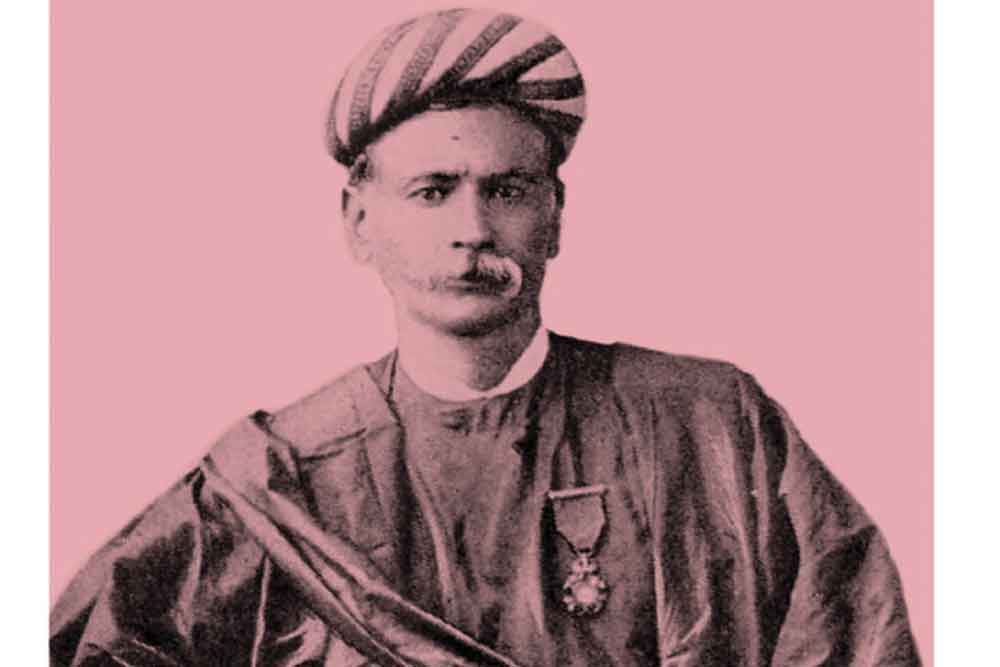
Ganguli’s translation comprises approximately 7400 demy octavo pages—equivalent to nearly 25 volumes, each containing 500 pages. This bridged the gap between the Sanskrit original and the English-speaking world.
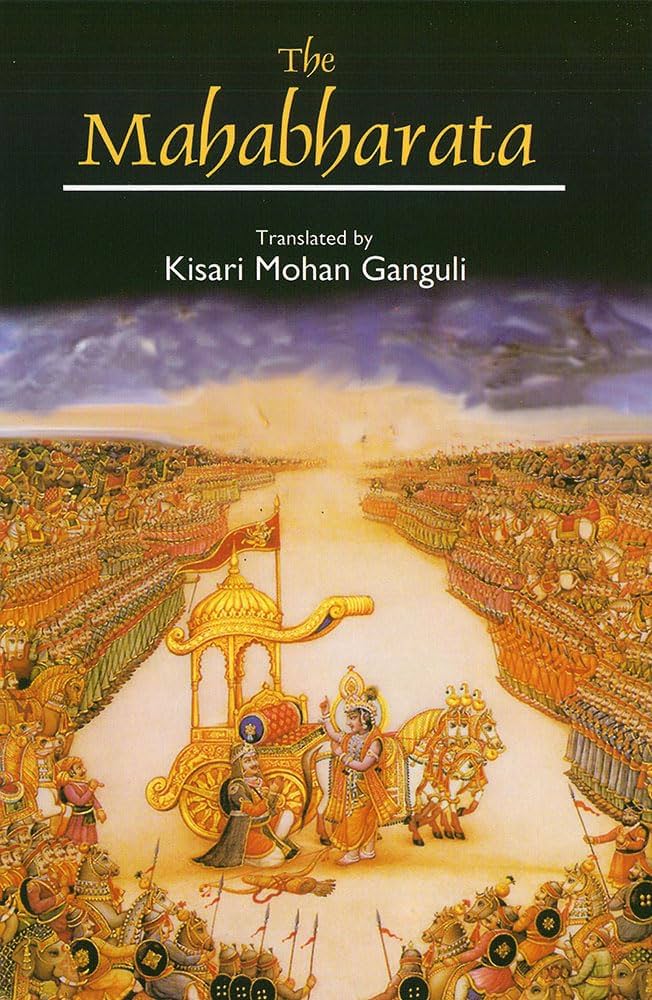
How Vyasa Structured Mahabharat?
Vyasa wrote the Mahabharata as a massive epic, arranged in a number of books, also known as parvas. Each Parva has its own distinct significance and content. The story unfolds as a complicated story of rivalry, honor love, duty, and loyalty between two rival clans – the Pandavas as well as the Kauravas. The story is centered around the struggle for power over Hastinapura’s kingdom, as well as the battle between righteousness – Dharma and Evil- Adharma. Here are all the 18 chapters of Mahabharata:-
- Adi Parva: The Beginning
- Sabha Parva: The Assembly Hall
- Vana Parva: The Forest
- Virata Parva: The Book of Virata
- Udyoga Parva: The Effort
- Bhishma Parva: The Book of Bhishma
- Drona Parva: The Book of Drona
- Karna Parva: The Book of Karna
- Shalya Parva: The Book of Shalya
- Sauptika Parva: The Book of the Sleeping Warriors
- Stri Parva: The Book of the Women
- Shanti Parva: The Book of Peace
- Anushasana Parva: The Book of Instructions
- Ashvamedhika Parva: The Book of the Horse Sacrifice
- Ashramavasika Parva: The Book of the Hermitage
- Mausala Parva: The Book of the Clubs
- Mahaprasthanika Parva: The Book of the Great Journey
- Swargarohanika Parva: The Book of the Ascension to Heaven
FAQs Around Who Wrote Mahabharata
Who Is The Real Writer Of Mahabharata?
Mahabharata was written by the sage Vyasa. Born as Krishna Dvaipayana, he came to be known as Vyasa, meaning ‘the compiler,’ as he is credited with the compilation of the Vedas, the ancient scriptures of Hinduism, and the writing of Mahabharata.
Is Mahabharata Real Or Myth?
While its mystical aspects place it in Sanatan mythology, evidence suggests real-world connections. A battle at Kurukshetra, artifacts, and submerged cities align with its narrative.
Who Wrote Mahabharata, Ganesha Or Vyasa?
Vyasa conceived Mahabharata and it was Ganesha who wrote down the entire epic as Vyasa convinced Lord Ganesha to be his scribe.
Did Vyasa Wrote Vedas?
Vyasa, also known as Veda Vyasa, compiled the Vedas into four texts: Rigveda, Samaveda, Yajurveda, and Atharvaveda.
Conclusion
The Mahabharata, an ancient Sanskrit Epic was written by Vyasa and translated by K.M. Ganguli in English. the Mahabharata, an ancient Indian epic, bears the imprint of Vyasa—a sage, poet, and seer. Vyasa’s monumental work weaves together myth, philosophy, and heroism, chronicling the epic struggle for sovereignty between the Pandavas and the Kauravas. His legacy endures, inspiring generations to explore the timeless wisdom embedded in this grand saga. In this post, we discussed who wrote Mahabharata and what the process was. If you love reading about Sanatan Mythology, especially around Mahabharat, do check out the rest of our blogs.
